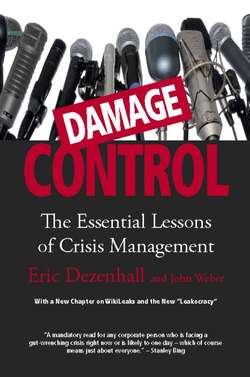Читать книгу Damage Control (Revised & Updated) - Eric Dezenhall - Страница 19
На сайте Литреса книга снята с продажи.
A CAUTIONARY TALE: HOW AUDI GOT SIDESWIPED
ОглавлениеOn November 23, 1986, the media introduced Americans to a compelling cast of characters and a blockbuster narrative. This murder mystery featured a reverend and his wife, their six-year-old boy, and his murderer: a seemingly possessed automobile, the Audi 5000.
This narrative came via CBS’s 60 Minutes, the television news magazine program known for its hard-hitting investigative reports. In the aptly titled segment “Out of Control,” an understandably distraught Kristi Bradosky alleged that her Audi 5000 lurched forward in her garage, unprompted, killing her young son, Joshua:
Bradosky: I got back into the car and put my foot on the brake to put it in drive, and the car surged forward, and I saw that I was going to hit him. So, I put my foot on the brake [again], but it didn’t stop the car. (Crying) It pushed him through the garage. And we had a panel partition, and it went through the partition. He went through it. (Crying)
Ed Bradley (CBS): You put your foot on the brake.
Bradosky: Mm-hmm.
Field demonstrations shown on the broadcast depicted an Audi—with no one in the driver’s seat—zooming ahead. An executive of Audi of America explained the physical impossibility of the runaway car, but he was overwhelmed by a prosecutorial Ed Bradley and the audience’s visceral identification with Bradosky’s grief.
The broadcast was a disaster for Audi, and a new mechanical syndrome, “sudden acceleration,” was born. No matter how hard a driver pressed down on the brake, the car would keep zooming ahead, Audi owners insisted.
We played a small and invisible role in this drama. We were young executives working for a communications consulting firm that had been assigned to the Audi case. One of our assignments was to track all of the local news reports of “me-too” incidents of runaway Audis that proliferated across the country in the days following the 60 Minutes broadcast. Local media outlets began picking up on the same narrative—the car just took off by itself!—and broadcasting their own versions of the Bradosky saga, though none had resulted in a death.
We vividly remember explaining to an investigative reporter in a Boston newsroom (who had located her own set of victims) that the car’s brake can always override the accelerator. In a statement that has haunted us for twenty years, the reporter pointed to the camera, and said, “But they don’t know that.” What did she mean? That it was her job to educate the public? Or the opposite ... that it was her job to validate a preexisting belief independent of the facts?
Despite these questions, we remembered the admonition of our superiors: Be nice. After all, we were dealing with a story driven by a woman whose grief was legitimate even if her version of events was questionable.
The 60 Minutes report was a blockbuster news story. Government investigations began. A support group, closely linked with plaintiffs’ attorneys, sprouted up. Called the Audi Victims Network, they soon were selling T-shirts. Audi, for its part, was assertive in defending its product but was committed to its public relations mantra: Be nice. Be nice.
CBS repeated the broadcast in September of the following year with an update citing 1,200 reports of sudden acceleration, including 5 deaths and 400 injuries. The supposedly mechanical syndrome became sufficiently accepted as real, and it began mysteriously migrating to other automobiles involved in crashes.
By the end of 1987, the Audi matter was more in need of attorneys than it was public relations people.
We remember being stunned a few years later to learn that all the people who sued Audi lost their cases, including the Bradoskys. Kristi Bradosky, whose tragic story was the emotional locomotive of the marketplace assault, later admitted under oath that she might have told the police officer who arrived at the scene of her accident that her foot had been on the accelerator when the accident happened, a very different scenario from sudden acceleration. Another woman, who was featured in the 60 Minutes report “teaser,” was later fined $20,000 for filing a frivolous lawsuit.
In 1989, when the Audi furor had subsided, the government’s National Highway Traffic Safety Administration, spurred into action by 60 Minutes’s Audi segment, released a report concluding that there was no mechanical basis for “sudden acceleration,” and said most of the accidents were probably caused by driver error. The drivers had most likely placed their foot on the accelerator.
It also came to light that the 60 Minutes footage of the suddenly accelerating Audi had been choreographed by an automotive consultant who remotely fed fluid into the transmission, thus rigging the car’s televised lurch. Litigation expert Walter Olson wrote in the National Review, “The tank with its attached hose was apparently sitting right on the front passenger seat of the doctored Audi, but the 60 Minutes cameras managed not to pick it up.”
Despite the failure of one single allegation of sudden acceleration to hold up in court, Audi’s sales didn’t recover for more than a decade. The company had lost “billions,” according to one executive. Audi sales, which had peaked at 74,000 the year before the 60 Minutes broadcast, plunged to an annual average of 14,000 in the early 1990s, a market share loss of more than 80 percent.
“We had a choice of suing [60 Minutes],” said Philip Hutchinson, an Audi official, years after the episode. “If we had won, it would have been a Pyrrhic victory. If we had won, what would Audi’s sales have been?”
